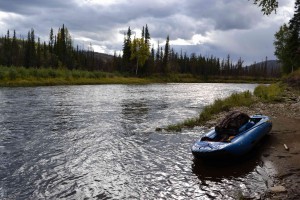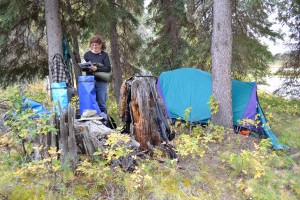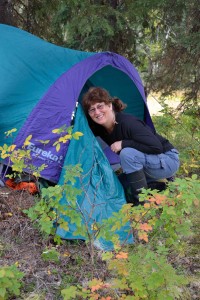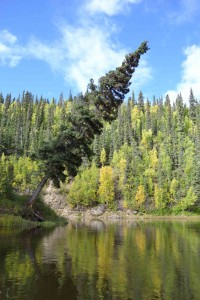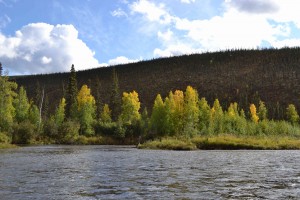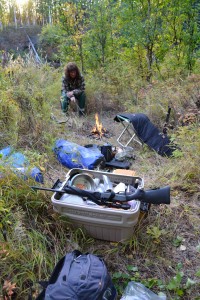After returning from a wonderful trip to Europe, life was back to its hectic norm for a couple of weeks, but Rose and I planned to take a float trip down the Chatanika River—just like the one Dad and I had gone on moose hunting back in September 2000. During that former trip, I remembered thinking how much Rose would enjoy such a float, and rumor had it that the 15-mile road off of Murphy Dome Road (which had been very bad before) had been improved for fire fighting earlier this year. So we planned to go. When Dad and I had gone, we’d taken a standard 18-foot aluminum canoe, but we’d worried about the extra load a moose would add and so had brought along an inflatable raft to tow if necessary. That scheme unfortunately was never put to the test, but in talking with some guys at work I heard a resounding recommendation for an inflatable Pro Pioneer made by Soar. I was able to rent one from the folks at Test the Waters, and we were set.
In the late afternoon on 31 August (Wednesday) we dropped the Ford truck off at the end of the 15-mile road off of Murphy Dome for our pickup. The road was indeed much improved, though a dry early fall helped. I made a big mental note to remember to bring the truck key on the float trip. Before dawn on Thursday, we set out in the small truck for the bridge on the Elliott Highway that crosses the Chatanika. To our surprise, there was not a single other vehicle parked in the lot at the boat landing. We would learn why in a couple of hours. This lack of congestion made putting in very easy, though. Using a handy little electric pump that hooked up to the truck battery, we had the boat inflated and in the water in less than ten minutes, and we were loaded and out of there very soon afterwards.
It was a cool, overcast morning with some very light rain initially—good for moose hunting. But this was a float trip on which I was bringing my rifle, not a full-out hunt. That makes not getting something a perfectly suitable outcome. And as soon as we floated silently around the first bend and left everything behind us, the tranquility, beauty, and solitude of the river promised that “suitable” was going to be a low bar in the search for adequate adjectives. It was spectacular. We floated leisurely along with occasional paddling. We stopped at a few likely moose-looking places, and there was sign, but we spent most of the time on the water, it seemed, going slowly and peacefully along. There were a lot of beavers (Castor canadensis), as Dad and I had remembered, and Belted Kingfishers (Megaceryle alcyon) flew from perch to perch in front of us as we went. American Wigeons (Anas americana) also played a sort of tag, always being pushed along in front but, unlike the kingfishers, never figuring out that they just needed to circle around behind to get rid of us completely.
The cool day had us a little chilled, so we put out on a sand bar and made some hot water for coffee and instant oatmeal. Both were excellent, and on each subsequent day we happily continued this custom. (This was when I discovered that I had forgotten to bring the damned cups. I could see them in my mind sitting at home waiting where I’d left them to be packed. We had to make do with a cheesy little aluminum, folding-handle deal that was really a pot lid that some backpacking guru no doubt spent a lot of time designing back in the dark ages. Oh well, it was better than nothing, and the cups proved to be the only forgotten items.) We were soon on our way again, fortified until lunch, which we had on a sunny bank in great weather. Bald Eagles (Haliaeetus leucocephalus) and Osprey (Pandion haliaetus) were both conspicuous on the upper reaches of the river, and Rose even found an eagle nest with what appeared to be a young bird perched next to it. It made some strange screaming sounds.
It was a couple of hours into the trip that we found out the reason for an absence of vehicles at the bridge landing: people were putting their boats in farther down, on the south side of the river where the pipeline crosses. Above that the river is a bit wilder, with more uncleared blockages. But even below that we were surprised at how little traffic there was on the river. All day long we saw only two boats go by us and just a few more tied up on the banks. In mid-afternoon we passed some napping hunters who had passed us earlier in a canoe with a five-horsepower motor on it. And we passed another hunter sleeping in a chair in front of his cabin with a fire in front of him almost out of control. We saw both again later out hunting the river corridor. Before deciding to camp for the night, we saw one female moose, a yearling, who just watched us go silently by. We set up camp at about six at a decent looking spot—not very moosey, but nice enough—and we soon had the tent up and a cheery blaze going. We heard not a single shot all day, odd for the first day of moose season.
The next morning was very cool and foggy. The local area was not worth hunting on foot, so after I sat for awhile quietly looking and listening for moose we had a quick hot breakfast, struck camp, and were loaded up and on our way by 7:00 a.m. It was eerily quiet floating along silently in the fog. We saw three more moose, but all were females. A cow and her yearling calf were at a spot on a very steep bank, with the yearling down in the water. It kerplunked its way step by noisy step in front of us for a ways trying to stay at a safe distance from us until it eventually found a slightly less steep spot and, like a mountain goat, hiked itself up onto the top of the bank and moseyed off. The beavers were busy again, and we could often hear them gnawing away on birch or aspen before we saw them. The gnawing, coupled with their seemingly poor eyesight, caused a couple of them to be terribly surprised by us. We snuck right up on these, laughing silently at their furious breakfast gnawing, and when they finally realized that a large blue monster was on top of them they slapped their tails again and again in exaggerated outrage.
At one bend we heard a low sort of grumbling-mumbling-chuckling, and eventually Rose spotted a porcupine (Erithizon dorsatum), who was talking to himself about the big blue boat. As we passed it, perched up on a fallen tree trunk, it pointed its backside at us, with the long hairs pulled up and his quills showing—a perfect display of “don’t get any closer.” Gray Jays (Perisoreus canadensis) were everywhere on the whole trip, always talking loudly (seldom using their indoor voices) and using a surprising number of vocalizations. Overall, they might be summed up as a sort of “Hlo? Hlo? Scandal! Scandal! Scandal!” They were a lot of fun to watch. We’ve been getting quite a few in the backyard, attracted by suet and chokecherries, but out here on the river, living among them, we got to see a lot more of their sociality and interactions in their natural environment.
On the first day I had gotten used to Rose pointing out wildlife that she saw (my eyes focused on the moose zones). Today, as the fog was clearing, it looked like she was pointing down—and then when she switched to pointing to the other side, I could see that she was indeed pointing down at the water. It was a shrew (Sorex sp.), swimming across the river! We both watched it in surprise; its legs moved at an incredible pace, and it cruised rapidly along. Suddenly, a fish struck from below and in a swirl of water the shrew was swallowed up. We both gasped in shock at seeing this—and then it popped back up again, still swimming mightily for the bank. And then the fish struck again! We were only slightly less shocked at seeing this mighty shrew disappear a second time. Then it popped up again! And it was still swimming frantically for the now closer bank. And then the fish struck a third time, and again the mighty shrew disappeared in a swirl of water. Unbelievable! It finally popped up one more time, still swimming mightily, and it soon made it to its destination and scrambled quickly up the bank. What an epic tale! What a wildlife adventure! Rose and I talked about it for the rest of the trip. We named the shrew Watersprinter, and Jonah, and we wondered how this mighty shrew had beaten the fish. We never got a decent look at the fish, but it must have been too small to handle such a mouthful—or maybe it was too timid when its mouth was full of angry shrew. Anyway, this was the best wildlife adventure we saw on the whole trip.
We stopped periodically to look for moose, but none were about. Varied Thrushes (Zoothera naevia) would occasionally sing their loud, plain song, Ruby-crowned Kinglets (Regulus calendula) could sometimes be heard whisper singing, and there was a lot of activity from several species of sparrows. We gradually got into boggier, black spruce habitat, where moose densities were really low. We pulled up onto the banks in some places to take a look, but we spent most of the time floating quietly along. Once again we had lunch on a sunny bank, and we stopped for the day in mid-afternoon at a very nice moosey spot on the edge of a forked oxbow lake. We pitched camp quietly and laid out salvaged firewood without breaking any up (in order to keep the noise down), then we relaxed the rest of the afternoon away. We had a great fire and dinner, and I could sit on a camp stool looking out over both the lakes and this section of the river—but no moose showed by dark.
As twilight approached, we heard two very large birds take off from a lake farther back off the river that we couldn’t see, and soon a very large pair of Trumpeter Swans (Cygnus buccinator) came flying low and strong over our camp, their flight feathers making quite a bit of noise in slicing through the air. They were both adults, and they gave a deep trumpeting as they flew over on their way to parts south.
On the third morning there were still no moose around, so we packed up camp and hit the river again. We were in slow-flowing bog country for several hours, and we mostly just paddled. There was a little light rain in mid-morning, but overall we had another very nice day. Once out of the bog country and into the hills, the current picked up and we went over series of shallow riffles at a good clip. This was fun, especially after the slower spots we’d just been through. We soon hit more cabins (seemingly quite a few more than when Dad and I had done this trip) and signs of the fire scarring that occurred here this spring. There were quite a few “scorched porch” cabins—structures saved from the flames, but barely. One was lost.
The faster current and the less winding nature of the river’s course took us much more rapidly across the land, and with our speed, the fire scarring, and increased human activity we decided to push on for the pullout. We’d heard no rifle shots at all on our first and second days. On this last day, in the four-wheeler zone around Murphy Dome, we’d heard one shot followed by silence for several minutes, but then a series of shots suggested a messy situation. As it had last time, the pullout came up on us suddenly, and here, too, there was no evidence of successful hunters. We pulled out just before 7:00 p.m. and were packed, loaded, and driving out in good time (I had remembered to bring the truck key). We were happy to have had beautiful weather and a great trip!

